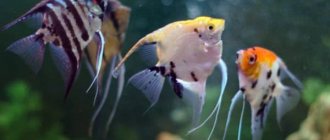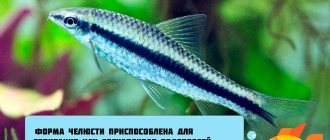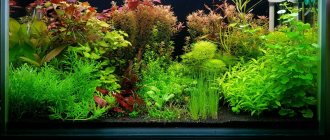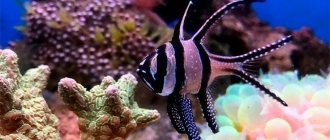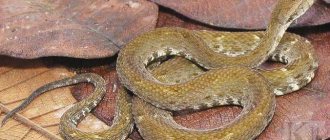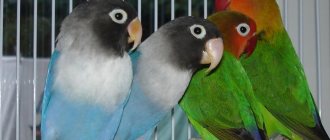Parrotfish is from the ray-finned family; more than 100 species are classified. She has a colorful coloring and a peculiar head shape, similar to a bird's beak. The aquarium fish was developed in Taiwan by crossing Cichlases, different species of American cichlids. Breeders still keep the details of their work secret.
It appeared in Russia at the end of the last century. Due to its unpretentiousness and unusual appearance, it is in demand among beginners and experienced breeders.
- 1 Description and natural habitat
- 2 Mr. Tail recommends: variety of species and color
- 3 Basics of aquarium keeping
- 4 Compatibility
- 5 Feeding
- 6 Breeding
- 7 Diseases and prevention
- 8 Interesting facts about the Parrot fish
Description and natural habitat
Marine Parrotfish live in the coastal waters of the Gulf of Mexico and the Caribbean Islands, the Indian and Pacific Oceans at depths of 2-20 m. Forming small schools, they occupy a territory that is comfortable for themselves and drive away those who try to penetrate it. Life expectancy is about 10 years.
They are hermaphrodites, they are female for half their life, then they change sex. They lead a diurnal lifestyle. Fish are omnivores, feeding on oysters, mussels, snails, and algae.
Freshwater Parrots in an aquarium grow up to 20-30 cm, their life expectancy is 7 years.
They are distinguished by a very small mouth, large lips that do not close completely. Teeth fused to the jaw. The dorsal and pelvic fins are triangular, reminiscent of the wings of a parrot, their bases are parallel to each other, small. The body is short, side-shaped, bright in color. The spine and swim bladder are deformed and curved, which affects swimming ability. The nose is like a bird's beak. Fangs and incisors protrude outward.
Photo gallery of Parrot Fish:
During the spawning period, males lure females to secluded places where they spawn. The male fertilizes the larvae floating in the water. The female is able to change sex and perform male functions.
Yellow-bellied pelvicachromis humilis, Boulenger, 1916
The male is beige-gray with yellow gill covers and belly, 7–8 brown stripes across the body and red edging along the unpaired fins.
The female has a crimson belly, turquoise gills and a border along the top of the tail.
Body length: 13 cm.
Water parameters in the aquarium: t 24 – 27 C; pH 5.0 – 7.5; dH 0 – 12.
Food: omnivore.
Habitat: Southeast Guinea, Liberia, Sierra Leone.
Mr. Tail recommends: variety of species and colors
There are many types and colors of fish. The most common:
- Red is a hybrid, not found in nature, obtained by crossing. Reaches 25 cm, scales are red-orange. Beak with sharp fangs and incisors. Changes color several times as it matures. Calm, peaceful.
- Scar - dwarf up to 20 cm, large up to 100 cm, they have many varieties, for example - dark, striped-bellied, Red Sea, guacamaya.
- Common - up to 10 cm, silver-blue in color, with a golden stripe along the back. The dorsal and anal fins are pointed.
- Green Boneface (Japanese) is a large, aggressive species. Reaches 100 cm in nature and can live up to 40 years.
- Pearl - up to 15 cm, no deviations in appearance. Body color is olive, orange, brown with small white spots.
- Blue – reaches 70 cm, bright blue color, distinguished by a large jaw and powerful fangs.
Parrotfish are also distinguished by the shape of their fins and bodies:
- King Kong has large fins and a layer of fat on the forehead.
- Red ingot - the body looks like a disk.
- Red Fortune - a huge beak-like growth, long fins.
- Love Heart – Rear fin missing.
- Unicorn - there is a seal on the head that looks like a horn.
- Diamond – up to 20 cm. Adult males with a hump on the head.
The colors of Parrots include lemon, yellow, blue, purple, black, marbled, white with black spots. Sometimes breeders, in order to get two-color fish, artificially color it, even apply tattoos, but this leads to great stress and early death of the individual.
Blue tiger parrot
655 6 min.
In the next couple of weeks, we are all doomed to remember that the coming year 2022 has been defined by Eastern sages as the year of the Tiger, and water and blue (and in some variations - black). However, black or blue - what's the difference? Where have they seen this in their China? Yes, so that he could also be a water one? Well, yes, tigers do not treat water with such aversion as other felines, but this does not make them so aquatic. In general, we have assigned a mythical animal as the symbol of the year; you can’t bring one into your apartment and you can’t make a pet out of it. Simply because it doesn't exist.
However, it is hardly wise to include even the most ordinary, real tiger as a four-legged friend - unless, of course, you are Brother Zapashny or Joe Exotic. And the fact that some people sometimes keep anyone in their home zoos, be it lions, tigers, or gorillas, should not serve as an example for us. In a word, we had to look for a decent replacement for the tiger in the form of someone slightly tiger-like.
I was tempted to recommend a tiger shark as a New Year's gift - it is certainly aquatic and even blue to some extent, although in reality it is rather gray. But still there are terrible teeth, five meters long, the need for a giant swimming pool, and even a bad temper. Making friends with such a fish is even more difficult than with a tiger: the tiger may not eat you yet, but this fish will definitely eat you, you just give it this opportunity. And in order not to be devoured, we will have to follow in the footsteps of fans of Damien Hirst’s work and buy a shark in formaldehyde. This is, of course, art. But still... What disgusting!
In general, everything was leading to the fact that, as a New Year’s animal, I would be forced to offer you another cat, but with stripes. And perhaps even bluish - cats have this color. Or black, there are plenty of them. But water? There were problems with this.
But then on our life’s path we came across the ideal option: the blue tiger parrot fish. He is also a sapphire mini-parrot, polar blue parrot or zebra parrot. However, we, of course, will focus on the tiger version.
Blue tiger parrots live in nature... They do not live anywhere, they do not exist in nature: this type of fish is an artificially created hybrid. Moreover, the hybrid is relatively fresh, created only five or six years ago. And it happened somewhere in Asia - most likely in Taiwan, but this is not certain, because everything is classified. The ancestors of our parrot are also classified - it seems that the aquarium world guards its secrets no worse than the developers of the latest hypersonic weapons. One thing is clear: our tiger belongs to cichlids, or cichlidae, a large family of the class of ray-finned fish. A variety of cichlids live freely in fresh or slightly brackish waters almost all over the world. I mean, almost all over the warm world. Even in our south, representatives of this family were discovered, but in Russia, of course, they are not natives at all, but simply descendants of fish that somehow escaped from aquariums and somehow settled here.
Yes, the authors of this lovely fish did not want to divulge the story of its origin, but knowledgeable people are almost sure: the blue tiger parrot was born from the union of a red parrot and a black-striped cichlid! At the same time, the red parrot, which, contrary to the obvious, does not have to be exclusively red, is itself also a hybrid. This artificially bred aquarium fish, concocted from several other cichlasomas (cichlasomas are a genus of fish in the cichlid family, but there, in these genera and families, something is constantly shuffled, so let's not go into tedious details), it turned out to be quite large, up to 25 centimeters tall, very pretty and with a sweet disposition. This parrot has a soft and friendly character and usually does not offend even its smaller comrades in the aquatic world.
But the second supposed half of our tiger - the black-striped cichlasoma - is a completely natural creature, which from time immemorial has inhabited the streams and lakes of Nicaragua, Guatemala, and Honduras. Panama and Costa Rica. She is 10–15 centimeters tall, all silver and striped. That's who gave the blue parrot the tiger coloring!
These are, apparently, the parents of our tiger. I wonder how the supposed Taiwanese inventors managed to persuade a large, sedate red parrot to have intimacy with a rather sharp and sometimes aggressive black-striped baby? Or did they not have any intimacy, but were just biologists, or ichthyologists, or simply aquarium scientists armed with a pipette - or whatever else is needed for artificial fertilization of eggs? So there was no romance at all? It's somehow sad.
Well, the fish turned out to be not sad at all, but absolutely charming - small, about five or six centimeters, bright blue, strong, with a thick dorsal fin and elegant stripes. And with a completely “parrot-like” face, extremely hook-nosed, and truly reminiscent of the beak of some macaw. Moreover, her lips are funny, plump, as if they were always pursed for a kiss. In general, a nice fish, a decoration for any aquarium.
Moreover, the decoration is quite unpretentious. You just need a fairly spacious aquarium - the tiger itself may be small, but putting it in a pickle jar is inhumane. But a sixty-liter container for a couple of these fish will be quite comfortable. Of course, until (and if) they begin to reproduce and their population begins to grow. By the way, unlike many other artificially created crosses, these hybrids reproduce quite willingly - apparently, this is an inheritance of the black-striped cichlosoma, known for its spontaneous fertility.
The ideal water temperature for them is 25–28°C, however, some of its fluctuations will not upset them too much either, these babies are not at all capricious, are not at all that fragile and know how to adapt, if not to everything, then to a lot. Of course, they need all sorts of aquarium gadgets like a water filter and an aeration system, well, everyone needs them, without such equipment you can’t keep fish. They are usually not too interested in plants in the aquarium, they are not the kind of fish that constantly pluck and bite everything, however, they will not object to greenery in their home. It will be more beautiful for you, and more interesting for them - after all, it is much more exciting to swim not just like that, in emptiness, but among wide leaves, as well as a reasonable number of grottoes and decorative snags.
Parrots are quite smart and quite curious fish; they, as a rule, quickly begin to recognize their owner and, when he appears, swim closer to the glass and enthusiastically watch human movements. Perhaps they're hoping for food, or maybe they're just curious about the world outside their glass house. Either way, as long as they are looking at you, you will be looking at them. And the soothing admiration of the life of such beautiful creatures is the main point of owning an aquarium. If you are not a breeder who breeds fish for sale (in our area, blue water tigers go for 400–1500 rubles, such is the price range), there is no practical benefit to you from them, only aesthetic pleasure and peace of mind.
Any kind of food is suitable for them; they will happily eat both dry food and live treats such as bloodworms or small shrimp, so it is not recommended to keep shrimp in the same aquarium as them. Like small snails, they can eat these too. It’s also not worth adding large fish to them - in this case, our tigers can go to lunch with stronger and toothier roommates. Well, these parrots usually get along well with most neighbors of their size - especially if they all moved in at the same time and, of course, if the neighbor is not particularly bloodthirsty (I would not risk sending gentle tigers into an aquarium even with the tiniest piranhas).
And they really are gentle - blue tiger parrots are considered fish with a calm and non-aggressive disposition. True, many cichlids are characterized by some territoriality, which is especially aggravated during the breeding season. It happened that small tigers, protecting their offspring, literally attacked their much larger neighbors like tigers. And by the way, they drove them far away.
Since the blue tiger parrot is a relatively new invention, its lifespan is not yet known exactly. Most likely, he will be able to live for ten years or even more. This means that you may well meet the next year of the Tiger fully armed: you will already have a tiger, albeit an old one, but one of your own.
However, apparently, the year 2034, if it comes at all, will be dedicated to not only a green or blue tiger, but also a wooden one. Well, then I’ll probably offer you the tiger python: it is olive, that is, almost green, and can hang beautifully from trees, and therefore can be considered in a sense wooden.
The main thing here is that we live to see this, which is what I wish for all of us.
Aquarium Basics
Parrots are unpretentious, tolerate temperature changes, and rarely get sick. But certain conditions must be observed to maintain them at home. The fish tank should be large, at least 150 liters. The aquarium is maintained at: water temperature - +26...+28 °C, hardness - 2-25 dh, acidity - 6.5-7.5 pH, nitrates no more than 30 mg/l. You need a pump for artificial flow, a compressor, a filter. The presence of ammonia and ammonium is unacceptable.
Maintenance is simple, the main thing is to regularly filter the water and ensure aeration. Lighting should be moderate, dim; if the color of the individuals is too bright, it will become lighter. Plants are placed on the sides, in the background. Parrots love snags and grottoes. They prefer to hide there; each individual should have its own shelter. A lid and a net are installed on top to prevent pets from jumping out. The soil should be made of small smooth pebbles and sand. Change the water every week by 20-30%.
Parrotfish are energetic, over time they recognize their owners, often become attached to him, wait, meet him, and allow themselves to be stroked. During stress or fear, they lose color.
What does it look like
In most cases, parrotfish have a bright red or orange color. It happens that the color becomes faded, to correct this, you should include carotene in the diet, and the color will become bright again. In rare cases, there are also albino parrots, whose color is white or pale yellow. They acquired other unusual colors (pink, blue, green) thanks to artificial dyeing. But after a while it starts to wash off. Also, parrot fish can have not only a solid color, but also a variegated, spotted one - it is present in the panda parrot (Panda Parrot), marbled parrot, diamond and pearl parrot (Killin Parrot).
Feeding
Due to the small mouth, not all food is suitable for Parrot Fish. They leave a lot of waste behind, and the aquarium has to be cleaned more often. Ready-made flakes, granules, and tablets for fish are recommended as food. Also, individuals will not refuse bloodworms, brine shrimp, shrimp, and worms.
To prevent the fish from losing their bright colors, they are given vegetables containing beta-carotene and protein (zucchini, bell peppers, lettuce). They are fed in small portions, twice a day; individuals should not eat too much to avoid obesity; they have a fasting day once a week.
Compatibility with other fish
Parrots get along well with fish:
- Catfish.
- Barbs.
- Ostronotuses.
- Aquarium arowanas.
- Black knives.
- Cichlids.
But fish smaller than 5 cm are not compatible with parrots; they can accidentally feed on them.
And also fish that feed on algae. For example, angelfish, because aquarium parrots make shelter from algae.
Breeding
It is impossible to distinguish males from females until 1.5 years of age. Males are larger, brighter, and their fins are pointed.
Unfortunately, most males of such hybrids are sterile and it is impossible to produce offspring. However, having reached maturity, they prepare for reproduction, having found a mate, the fish begin mating games. They dig a hole where the female lays her eggs, the parents guard the eggs. But it remains unfertilized and dies over time. If there are males of closely related fish in the aquarium, they are able to fertilize the eggs.
In this case, the fry are gray-black for up to 5 months. Then they turn bright orange. Parents feed their offspring by grinding pieces of food in their mouths and spitting out the suspension. You can also give young animals special liquid food.
Nutrition
As for the nutrition of these amazing fish, they are absolutely not picky in this matter. They have an excellent appetite. Therefore, those who decide to buy a Parrot fish must simultaneously purchase food for their new pet.
Their diet includes dry and live food; they absorb everything with great pleasure. Fish love bloodworms, tubifex, and shrimp. Their menu must include plant foods. The older the fish gets, the more its appearance loses its bright colors. You can support the variegation of Parrots with the help of carotene or shrimp.
Residues of food must be removed from the aquarium to help keep it properly clean. You should not overfeed your fish; it is better to accustom them to three meals a day.
Diseases and prevention
Parrots are generally disease resistant. But in dirty water, with an excessive number of inhabitants in the aquarium, the fish can get sick.
Black spots appear against the background of stress - reasons: poor presence of nitrites. Change the liquid in the aquarium and wash the soil.
The presence of white-transparent, thread-like excrement, lethargy, loss of appetite, and erosion on the head indicate the appearance of hexamitosis. Sick individuals are removed. Metronidazole, Furazolidone, Kanamycin, Ciprofloxacin are used after consultation with a veterinarian.
White spots that look like semolina indicate ichthyophthyriasis. The soil is siphoned, the filters are washed, and the individuals are fed less. Sulfur costapur is used in treatment - a special medicine, it is administered at night, the water is changed by 30%, the temperature is raised by 2 degrees.
If the fish is at the bottom, it means it has been poisoned or overeaten. The individual is removed and methylene blue is injected. Use Kanamycin, Metranidazole.
To prevent diseases, it is necessary to feed the fish only high-quality food, do not give food in excess, and add vegetables. Change the water periodically, filter it and do not overcrowd the aquarium.
Roloff's parakeet (Pelvicachromis roloffi), Thys van den Audenaerde, 1968
The male is light purple, the back is gray-brown, and the belly is light. Depending on the condition of the fish, a dark stripe may run along the body. The unpaired fins are yellow-brown, the dorsal with numerous dark spots, the anal with a dark edge, the tail with a dark spot.
The female is grayish-brown with a purple tint, her abdomen is crimson. The unpaired fins are orange, the tail has 3-4 black dots with a white border. The pelvic fins are dark.
Life expectancy in an aquarium is up to 4 years.
Body length: 9 cm.
Water parameters in the aquarium: t 24 – 27 C; pH 5.0 – 7.5; dH 0 – 12.
Food: omnivore.
Habitat: Sierra Leone, eastern Guinea, Liberia.
Interesting facts about the Parrot fish
The Marine Parrot Fish, which lives naturally in the Red Sea, the Mediterranean Sea, and the tropics, feeds on coral polyps and reaches a meter in length.
Before going to bed, individuals secrete mucus, it contains antibacterial substances, and it envelops the body. Thus, the created shell hides the smell from predators and protects against parasites. At dawn, the fish gnaw through the cocoon they have made and go in search of food.
At high tide, they enter lagoons, where they bite off their favorite delicacies - coral polyps - with strong jaws. In the pharynx, food is digested into fine dust. The fish cleans the coral of dead rocks, which it turns into sand.
Its meat is delicious, fishermen use all means to hunt the Sea Parrot, but catching it is prohibited in order to preserve coral reefs.
Albino morph of Pelvicachromis
Owners of albinos note the following feature - naturally colored males prefer albino females for mating, and all females prefer naturally colored males. Experts believe that the red belly, which is present in females ready to breed, acts as a magnet for males and appears better on albino females.
Habitat in nature
Pelvicachromis pulcher or the parrot cichlid was first described in 1901 and was first imported to Germany in 1913.
It lives in Africa, in southern Nigeria and the coastal regions of Cameroon. The water in which it lives is very different in parameters, from soft to hard and from fresh to brackish.
In nature, Pelvicachromis pulcher feeds on worms, larvae, and detritus. Most of the fish now found on sale are artificially bred; wild-caught specimens are almost never imported.
What to feed Pelvikachromis
It is not very difficult to please parrotfish in food. At the same time, a varied diet is the key to the health of your fish. Keep in mind: in nature, fish swim mainly near the bottom, so it would be a good idea to use sinking types of food. We recommend using high-quality food from Tetra.
It should be noted that when purchasing any dry food, you should pay attention to the date of its manufacture and shelf life, try not to buy food in bulk, and also store the food in a closed state - this will help to avoid the development of pathogenic flora in it.
